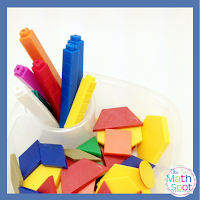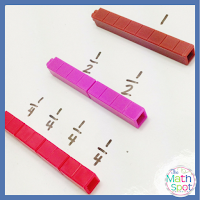This post contains affiliate links. This means that when you make a purchase, at no additional cost to you, I will earn a small commission.

 When I taught 4th grade special ed. I found that fractions in the context of a story made so much sense to my students. I would come up with elaborate scenarios – most involving food- that would start out by granting one student exclusive rights to an entire pan of brownies and would slowly erode their good fortune to the end of changing denominators and, ultimately, fraction learning. These were the days when I would hear cries of “You’re the best teacher ever!” and “Math is so much fun!”… I get it, I was feeding them brownies. But they were learning so this was a true win-win scenario.
When I taught 4th grade special ed. I found that fractions in the context of a story made so much sense to my students. I would come up with elaborate scenarios – most involving food- that would start out by granting one student exclusive rights to an entire pan of brownies and would slowly erode their good fortune to the end of changing denominators and, ultimately, fraction learning. These were the days when I would hear cries of “You’re the best teacher ever!” and “Math is so much fun!”… I get it, I was feeding them brownies. But they were learning so this was a true win-win scenario.
 In my first post of the comparing fractions series I talked about how students make connections based on what they know. Coming out of the primary grade levels our students know a lot about whole numbers- but the rules of the whole number world don’t always apply to fractions in the way that our kids think they will. It is so important to give our students opportunities to have concrete experiences with fractions so that they have solid anchors for their future fraction connections. My recommendation, however was not only to start with concrete experiences but to follow the concrete-representative-abstract (CRA) model.
In my first post of the comparing fractions series I talked about how students make connections based on what they know. Coming out of the primary grade levels our students know a lot about whole numbers- but the rules of the whole number world don’t always apply to fractions in the way that our kids think they will. It is so important to give our students opportunities to have concrete experiences with fractions so that they have solid anchors for their future fraction connections. My recommendation, however was not only to start with concrete experiences but to follow the concrete-representative-abstract (CRA) model.
This post will focus on a variety of concrete models and experiences that will help your students to form a strong anchor for their fraction learning. Anchors that you can easily connect to in representative and abstract ways through future lessons. I am recommending these in no particular order. Think about your students and the hands on experiences that you think might best resonate with them.
 A variety of fraction bars will be an indispensable tool when you are helping students to understand how to compare fractions. Cuisenaire Rods are a great first tool for exploration. Choosing one rod and naming it “the whole” ask your students to determine which color rod would represent 1/2, 1/3, 1/4 or 1/8. I love the connecting rods that I have listed under “tools” below because there is no risk of sloppy work leading to incorrect understandings.
A variety of fraction bars will be an indispensable tool when you are helping students to understand how to compare fractions. Cuisenaire Rods are a great first tool for exploration. Choosing one rod and naming it “the whole” ask your students to determine which color rod would represent 1/2, 1/3, 1/4 or 1/8. I love the connecting rods that I have listed under “tools” below because there is no risk of sloppy work leading to incorrect understandings.
In the same vein, fraction bars will allow your students to see a similar relationship between the size of the fraction pieces. In this model you are losing the opportunity for your students to discover on their own the relationship between the size of the pieces, however, depending on the task your students have been given, this is just fine. For example, if your students already have an understanding of naming unit fractions and you are asking them to compare a variety of fractions and report what they are noticing about the pattern of denominators, fraction bars will be the perfect tool for your students to use.
The last fraction bar model that I will mention- in this FAR from exhaustive list- is folded paper strips. Much like the Cuisenaire Rods, students will have an opportunity to reason about the size of the pieces as they are folding the strips into equal groups. I like this activity as more of an exploration because I will warn you that alternate conversations will emerge. Depending on the fine motor skills of your students, you will surely have students who do not fold into equal pieces.
Food is a natural opportunity for students to experience fractions in a “real life” scenario. It also allows students to bring common sense into the equation. If I am sharing a pizza with 10 friends I will obviously get less pizza than if I am only sharing with one other person. The key here is to make sure that as you are using food like pizza, brownies, chocolate bars… are you hungry yet?…that you ask questions that will allow students to connect this understanding directly to fractions. Use fraction language. Chart out what happens as you cut the food into more and more pieces. Ask students what they notice about the denominators. Ask them to make predictions based on what they are noticing in the numeric patterns and then keep cutting the food up (or putting pieces back together) to test their conjectures.
I’ll be honest. Most of the “epic” story problems I have written are about food. I’m not apologetic though, is is a logical and very relatable context for students. I use epic story problems along side a prop to allow students to experience changing numerators and denominators for themselves. An epic story problem may take a good 30 minutes and is really more like a play. I might start out by picking a student and saying something like “Julie woke up this morning and found that her mom had left her a chocolate bar with a note that said “Have a great day!” I would have the student come over and hold the chocolate bar. “Julie began walking to school and saw her friend Frank. Because Julie is SUCH A NICE FRIEND she shared the chocolate bar equally with Frank. Now Julie and Frank each have ______ of a chocolate bar.” I would have Frank come up to the front of the room and they would break the chocolate bar into 2 equal pieces each holding a half. I would continue this story, “Julie and Frank came across Tanya and Priscella and, because they are SUCH NICE FRIENDS they decide to share the chocolate bar equally with them as well!”
You can see where I am going with this story. I always made a big play of sentences as “such a nice friend” and the whole class would say the line together like some sort of strange game show. I guarantee that if you try this strategy engagement will be high in your classroom. Just be sure to chart your findings as you go so that you have a record to debrief and talk about during and after the lesson.
If you really want to go for it, you can turn the story around and have students deciding that they don’t want to each chocolate and giving their portion to another friend. You will be able to work in adding unit fractions and comparing fractions with the same numerator in this way. Your students really won’t think of this as “fraction work” until you chart the numbers to match because the context is so natural. This type of work helps to build the “right” kind of natural connections between what your students know and what you would like them to understand.
 Pattern blocks can be used much in the same way as the variety of fraction bars listed above. In fact, I would use them in almost exactly the same way that I described using Cuisenaire rods. In my next post I am going to talk about how to link these concrete models to representations in an effort to move towards more abstract and fluent thinking, but I will make the point now that pattern blocks are an easy tool to use to begin to make this transition because students can use pattern blocks to represent a comparison (one whole built with 1/2 pieces vs. one whole built with 1/6 pieces) and they can then trace those pieces to show their representation.
Pattern blocks can be used much in the same way as the variety of fraction bars listed above. In fact, I would use them in almost exactly the same way that I described using Cuisenaire rods. In my next post I am going to talk about how to link these concrete models to representations in an effort to move towards more abstract and fluent thinking, but I will make the point now that pattern blocks are an easy tool to use to begin to make this transition because students can use pattern blocks to represent a comparison (one whole built with 1/2 pieces vs. one whole built with 1/6 pieces) and they can then trace those pieces to show their representation.
I will touch on paper clips only briefly because they are the least connected fraction model, however, you can promote an understanding that it takes fewer large paperclips to fill a space than it does small paper clips. This understanding is found within a second grade geometry standard that I have written about here. <– That post also includes a free 2nd grade math activity that may be useful if you are a 3rd grade teacher just starting your fraction unit. This may be an unnecessary model if your students are able to grasp an understanding that lower denominators yield larger pieces, however, it is a tool to use if you have any students who still can’t quite make that connection for themselves!

The concrete tools that can be used to model fractions for comparison are really endless. The main
takeaway here is that these models are so very necessary to build strong anchors for your students. So, what can you do now that these anchors are built? Follow me into post #3 as we work towards fluency and number sense around fractions.
Post 1: The Math Spot Compares Fractions- Introduction
Post 2: The Math Spot Compares Fractions- Comparison Tools
Post 3: The Math Spot Compares Fractions- Representative Models
Post 4: The Math Spot Compares Fractions- Abstract Thinking
If you need any of the materials described in the post above, I have listed them below. I really recommend the “Connecting Rods”. I love them because, unlike many other Cuisenaire Rods I have used, these link together. I can also recommend the fraction bars and the pattern blocks. I do NOT recommend the last link for the ruler. $7.23 for one ruler is crazy!! I bought them for much less from the School Smart catalog and bought a few of each of the 1 inch, 1/2 inch, 1/4 inch and fully marked rulers so that I have a continuum to work from. The link is there just so you can see what I was describing 🙂









